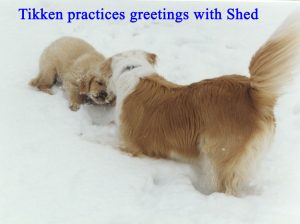< A version of this article was published in the Summer 2021 issue of Humanely Speaking, the newsletter of the Bangor Humane Society >
< Updated 11JUL21 >
< A short link for this page – https://bit.ly/BHS-SocBdyLang >
Every puppy has a critical socialization period that starts when we bring them home and ends between 12 and 16 weeks of age. After this period ends, a puppy will likely view anything new as a threat. Therefore, we must socialize our puppies by exposing them to new things in a planned and controlled manner while creating a positive association.
while creating a positive association.
Before beginning socialization, you must first understand canine body language, so you recognize when your puppy is uncomfortable. Incidentally, we see the same signals in adult dogs. Signs of anxiety can be as subtle as; avoiding eye contact, licking their lips, a tightly closed mouth, yawning, and scratching. If these signals do not cause the scary thing to go away, the puppy may give more emphatic signs such as looking away, panting, and trying to hide. When a puppy is terrified, it may growl, bark, lunge, or they may freeze in terror. Unfortunately, many people misunderstand the “freeze.” Since the puppy is not reacting, they believe the puppy is “fine” when in reality, they are terrified. NEVER force a puppy to interact with a living thing or object if they show any hesitation or signs of fear.
Body language indicating your puppy is comfortable includes; a loose wiggly body, an open mouth with their tongue hanging out, and a desire to investigate and move towards a person or object. Unfortunately, most people do not understand how dogs communicate. It is your responsibility to teach family, friends, and all other people who will interact with your puppy how to do so.
The best way to greet a puppy is to squat sidewise at a distance from the puppy and allow the puppy and person to approach you at their own pace. Alternatively, you can slowly move towards the puppy, avoiding direct eye contact and keeping your arms still. At the same time, the person with the puppy will feed them tiny, high-value treats. If the puppy shows any hesitation, stop and try another day. The puppy ALWAYS gets to make a choice.
Between 8 and 12 weeks of age, you need to gently expose your puppy to everything you anticipate they will encounter during their lifetime in a planned and controlled manner. That includes people of all ages, sizes, races, smells, and wearing a wide variety of clothing. Socialization also includes exposing a puppy to other animals and non-living things such as; cars, lawnmowers, boats, snowmobiles, brooms, snow shovels, and more, all in a planned and controlled manner.
Recommended Resources
Articles on Don’s Blog
( http://www.words-woofs-meows.com )
Essential Handouts On Body Language, and Canine and Human Behavior from Dr. Sophia YinPuppy – https://bit.ly/YinBodyLang
Socialization and Habituation – http://bit.ly/SocializationPuppy
How Can I Tell When My Dog Is Anxious or Fearful? – http://bit.ly/DogsSignsofFear
Especially for New Puppy Parents – http://bit.ly/EspcNewPuppyParents
Alone Training – http://bit.ly/AloneTraining
 Podcasts from The Woof Meow Show
Podcasts from The Woof Meow Show
( http://woofmeowshow.libsyn.com/ )
Podcast – Especially for New Puppy Parents – Part 1 – http://bit.ly/WfMw-Esp_Pups1
Podcast – Especially for New Puppy Parents – Part 2 – http://bit.ly/WfMw-Esp_Pups2
Podcast – Especially for New Puppy Parents – Part 3 – http://bit.ly/WfMw-Esp_Pups3
Don Hanson and Dr. Dave Cloutier on Puppy Socialization and Vaccination – http://traffic.libsyn.com/woofmeowshow/Pet_Tip_-Don_Hanson_and_Dr._Dave_Cloutier_on_Puppy_Socialization_and_Vaccinations.mp3
________________________________________________________________________
Don Hanson is the co-owner of the Green Acres Kennel Shop ( greenacreskennel.com ) in Bangor, Maine, where he has been helping people with their pets since 1995. He is also the founder of ForceFreePets.com, an online educational resource for people with dogs and cats. Don is a Bach Foundation Registered Animal Practitioner (BFRAP), Certified Dog Behavior Consultant (CDBC), Associate Certified Cat Behavior Consultant (ACCBC), and a Certified Professional Dog Trainer (CPDT-KA). He is a member of the Pet Professional Guild (PPG). Don is committed to PPG’s Guiding Principles and the Pain-Free, Force-Free, and Fear-Free training, management, and care of all pets. He serves on the PPG Steering Committee and Advocacy Committee and is the Chair of The Shock-Free Coalition ( shockfree.org ). Don produces and co-hosts a weekly radio show and podcast, The Woof Meow Show, that airs on Z62 Retro Radio WZON (AM620) and WKIT 103.3-HD3 streamed at http://bit.ly/AM620-WZON every Saturday at 9 AM. Podcasts of the show are available at http://bit.ly/WfMwPodcasts/, the Apple Podcast app, and Don’s blog: www.words-woofs-meows.com. The opinions in this post are those of Don Hanson.
©11JUL21, Donald J. Hanson, All Rights Reserved
< Click for Copyright and Use Policy >

